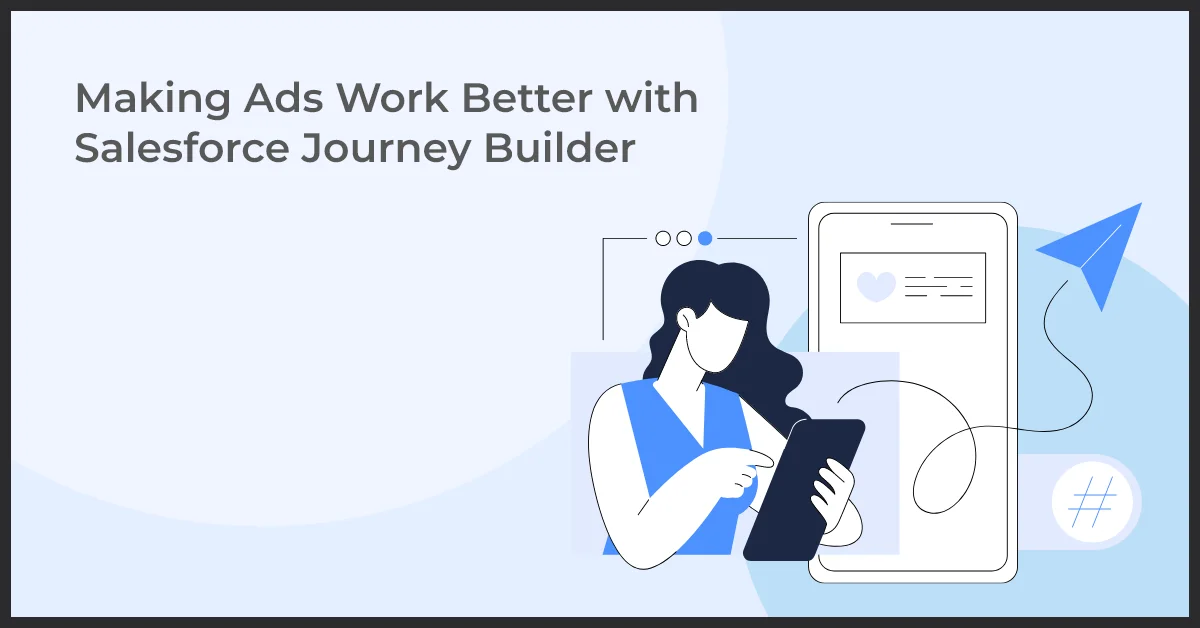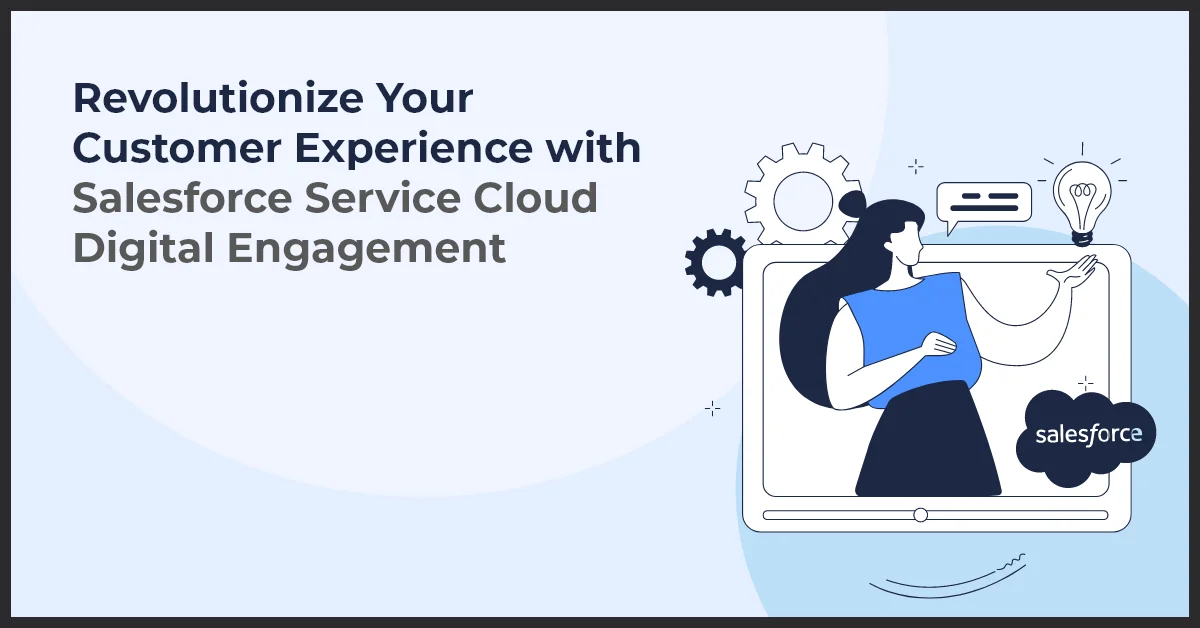Making Ads Work Better with Salesforce Journey Builder

Published on: July 25, 2023
Updated on: May 27, 2024
1494 Views
- Salesforce
10 min read
Creating ads that grab people's attention and lead to sales is important in marketing. Salesforce Journey Builder is a tool that helps marketers do just that. In this blog post, we will discuss why creating audiences for ads in Journey Builder is important, what it can do, and how it can work with other marketing tools.
We will also look at practical tips on making your ad campaigns more effective using Journey Builder. But before we dive into the details, here is a quick overview of Salesforce Journey Builder.
What Is Salesforce Journey Builder?
Salesforce Journey Builder is a tool that helps marketers plan and run marketing campaigns. It's like a map showing all the steps a customer goes through when interacting with your brand. With Journey Builder, you can create personalized campaigns for each customer so they get the right message at the right time.
What Can Journey Builder Do for Personalized Marketing?
Journey Builder helps you understand your customers better. You can divide them into groups based on age, where they live, what they've bought from you, and how they've interacted with your brand.
Journey Builder lets you create personalized messages and content for each customer. This makes them more likely to engage with your brand and buy your products or services.
It also allows you to reach customers on different channels, like email, text messages, and social media. This way, you can connect with them wherever they are.
How Does Journey Builder Work With Other Tools?
Journey Builder works seamlessly with Salesforce CRM, a system that stores all your customer information. This integration helps you keep track of your customers' details and coordinate your marketing and sales efforts.
It can also work with other marketing tools you use, like email marketing platforms and social media tools. This way, you can make your ad campaigns even more effective by utilizing the features of these tools together with Journey Builder.
Making Ad Campaigns More Effective with Journey Builder
- Matching Ads to the Customer Journey: To make your ads more effective, show them to the right people at the right time. Journey Builder helps you understand where customers are in their journey with your brand and choose the best time to show them ads.
- Using Customer Data for Targeted Ads: Journey Builder lets you use your information about your customers to create ads specifically tailored to their interests and needs. This makes the ads more relevant and increases the chances of customers responding to them.
- Automating Ad Campaigns with Journey Builder: Journey Builder has a feature that allows you to automate your ad campaigns. You can set up triggers and actions that make ads appear when customers do certain things or reach specific milestones. This automation helps you deliver ads immediately and make them more effective.
Making the Most of Customer Data in Journey Builder
Importing and Syncing Data from Salesforce CRM
In Journey Builder, you can bring and sync data from Salesforce CRM, which stores customer information. This helps you gather all the necessary data in one place for your ad campaigns. It ensures you have the most up-to-date customer information to create targeted and personalized campaigns.
Sorting Data and Building Audiences within Journey Builder
Journey Builder allows you to organize your customer data into different groups based on factors like age, location, past purchases, and interactions with your brand. This process is called data segmentation.
You can create distinct groups or audiences within Journey Builder by segmenting your data. These audiences can be targeted with specific ad campaigns catering to their preferences and behaviors. Data segmentation helps you deliver more relevant and personalized ads to your customers.
Defining Goals and Objectives
Identifying Ad Campaign Objectives within Journey Builder
Increasing Brand Awareness
One of the objectives you can set for your ad campaign in Journey Builder is to increase brand awareness. This means making more people aware of your brand and what it offers. With Journey Builder, you can design campaigns that help spread the word about your brand, reaching a wider audience and building recognition.
Driving Website Traffic
Another objective for your ad campaign can be to drive traffic to your website. This means attracting more people to visit your website and explore your products or services. Journey Builder allows you to create campaigns that entice and direct customers to your website, increasing the chances of engagement and conversions.
Generating Leads or Sales
Generating leads or sales is often a crucial goal for ad campaigns. Journey Builder enables you to create campaigns encouraging potential customers to take action, such as filling out a form or purchasing. By leveraging the capabilities of Journey Builder, you can design targeted campaigns that persuade customers to become leads or convert into sales.
Creating Customer Segments Based on Journey Builder Interactions
Defining Criteria for Segment Inclusion
When using Journey Builder, you can create customer segments by setting specific criteria for inclusion. This means deciding which customers should be part of each segment based on certain characteristics or actions. For example, you might include customers who have made a recent purchase or those who have interacted with specific campaigns.
Grouping Customers Based on Behavior and Engagement
In Journey Builder, you can group customers into segments based on their behavior and engagement with your campaigns. This means identifying customer patterns and actions, such as opening emails, clicking on links, or visiting specific web pages. By grouping customers with similar behaviors, you can create more targeted campaigns tailored to their interests and needs.
Dynamic Segmentation for Real-Time Targeting
Journey Builder offers dynamic segmentation capabilities, allowing you to target customers in real time based on their current behavior and interactions.
Customers can be automatically included or excluded from specific segments as they engage with your campaigns or take certain actions. Dynamic segmentation ensures that your campaigns stay relevant and up-to-date, providing a personalized experience for each customer.
Mapping Journey Stages to Ad Campaigns
Identifying Relevant Stages within the Customer Journey
Awareness Stage and Ad Campaigns for Brand Exposure
The customer journey consists of different stages, including the awareness stage. Customers become aware of your brand and what it offers at this stage. To effectively target this stage, you can create ad campaigns focusing on brand exposure.
These campaigns aim to capture the attention of potential customers, introduce them to your brand, and create awareness. Ads in this stage should highlight your unique value proposition and make a positive impression.
Consideration Stage and Ad Campaigns for Product Education
The consideration stage comes after the awareness stage, where customers start considering your products or services. In this stage, they gather more information and evaluate their options. You can create ad campaigns to engage customers in this stage that provide educational content about your products or services.
These campaigns showcase your offerings' benefits, features, and value. Ads in this stage should address customer pain points, answer common questions, and build trust by providing valuable information.
Decision Stage and Ad Campaigns for Conversion
Customers are ready to purchase or take a specific action in the decision stage. To drive conversions in this stage, you can create ad campaigns that prompt customers to decide.
These campaigns can include compelling offers, discounts, or incentives to encourage customers to act. Ads in this stage should create a sense of urgency, highlight the benefits of choosing your brand, and provide clear calls to action to drive conversions.
Setting Up Automation Rules for Ad Campaign Triggers
Event-Driven Triggers Based on Customer Actions
Journey Builder allows you to set up automation rules that trigger ad campaigns based on specific customer actions. These actions include opening an email, clicking on a link, purchasing, or interacting with your brand.
By using event-driven triggers, you can ensure that your ads are shown to customers at the right moment when they are most engaged and receptive.
Time-Based Triggers for Ad Campaign Scheduling
In addition to event-driven triggers, you can set up time-based triggers in Journey Builder to schedule your ad campaigns. This means you can determine specific dates or times when your ads should be delivered to customers.
Time-based triggers are useful when running time-sensitive campaigns or aligning your ads with specific events, promotions, or seasons.
Personalized Ad Content Based on Journey Stage
Journey Builder enables you to create personalized ad content based on the specific stage of the customer journey. As customers progress through different stages, you can automatically change the content and messaging of your ads to match their needs and interests.
By delivering personalized ad content that resonates with customers' current journey stage, you can enhance their experience and increase the likelihood of conversion.
Measurement and Optimization
Tracking Ad Campaign Performance within Journey Builder
Monitoring Campaign Engagement Metrics
Journey Builder allows you to track and monitor various engagement metrics to assess the performance of your ad campaigns. These metrics can include the number of impressions, clicks, conversions, and other relevant actions.
By closely monitoring these metrics, you can gain insights into how customers interact with your ads and identify areas for improvement.
Analyzing Conversion Rates and ROI
Conversion rates and return on investment (ROI) are important indicators of ad campaign success. Journey Builder provides tools to analyze conversion rates, which measure the percentage of customers who take the desired action after viewing your ads.
ROI helps you understand the financial impact of your campaigns by comparing the cost of running ads to the revenue generated. By analyzing conversion rates and ROI, you can evaluate the effectiveness and profitability of your ad campaigns.
A/B Testing and Optimization Strategies
Journey Builder offers A/B testing capabilities, allowing you to compare different versions of your ads and identify which performs better. By testing variables such as ad copy, imagery, or call-to-action buttons, you can optimize your campaigns for improved results.
A/B testing helps you make data-driven decisions and refine your ad content to maximize its impact on the target audience.
In addition to A/B testing, optimization strategies are crucial in maximizing ad campaign performance. Journey Builder provides insights and data that can guide your optimization efforts. To increase their effectiveness, you can adjust your campaigns, targeting, and messaging by analyzing customer behavior, preferences, and journey stage data.
Final Thoughts
Salesforce Journey Builder offers marketing managers, C-level executives, marketing automation professionals, and other marketing folks a powerful tool to create effective ad campaigns that align with the customer journey.
By utilizing Journey Builder's features and capabilities, marketers can leverage customer data, personalize content, automate campaigns, and integrate with Salesforce CRM and other marketing tools to enhance the effectiveness of their ad campaigns.
To fully harness the potential of Salesforce Journey Builder and drive growth through Salesforce, partnering with a leading Salesforce consulting agency can be highly beneficial.
Growth Natives boasts a team of 7X Salesforce administrators with over 60 certifications and over 100 years of collective experience. We have a proven track record of serving clients globally and helping them succeed with Salesforce.
Whether implementing Journey Builder or leveraging other Salesforce solutions, Growth Natives can provide the expertise and guidance needed to maximize the effectiveness of ad campaigns and drive business growth.
Choose Growth Natives as your trusted Salesforce consulting partner and unlock the full potential of Salesforce Journey Builder to take your ad campaigns to the next level. Email us at info@growthnatives.com and we will get back to you at the earliest.
Frequently Asked Questions
Salesforce Journey Builder is a tool that allows marketers to create and automate personalized, multi-channel customer journeys based on their interactions and behaviors.
The key difference between Automation Studio and Journey Builder lies in their functionality. Automation Studio is primarily used for batch-oriented, scheduled tasks like data import/export and email sends, while Journey Builder focuses on orchestrating real-time, personalized customer journeys across multiple channels.
Journey Builder allows users to create several types of journeys, including Email Journeys, Engagement Journeys, Transactional Journeys, and Custom Journeys, each tailored to specific marketing objectives and customer interactions.
Three benefits of using Journey Builder include:
- Personalized Customer Journeys: Tailor interactions based on customer behavior and preferences for a more engaging experience.
- Multi-Channel Orchestration: Seamlessly integrate email, mobile, advertising, and other channels to deliver consistent messaging across touchpoints.
- Real-Time Engagement: Trigger actions and responses in real-time based on customer interactions, enabling timely and relevant communication.



